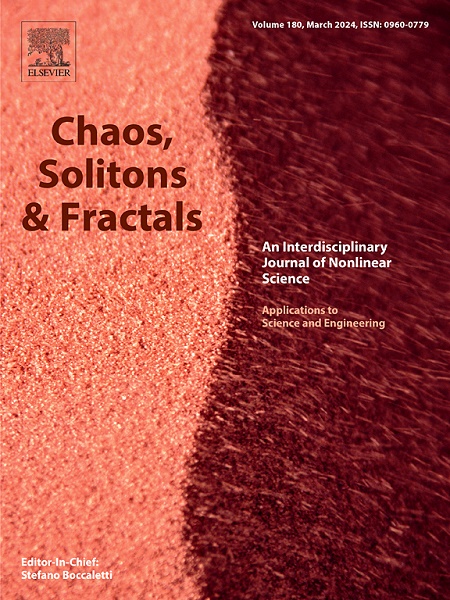动态曼德尔布勒分形:使用距离估计的时间演变的三维分形的数学框架
IF 5.3
1区 数学
Q1 MATHEMATICS, INTERDISCIPLINARY APPLICATIONS
引用次数: 0
摘要
本文提出了一种新的方法,通过在其迭代构造过程中引入动态空间变换来生成时变曼德尔布勒分形。通过嵌入平滑变化的正弦平移(由全局时间和迭代指数缩放),并将xy平面上的相位驱动旋转与格林威治标准时间同步,分形的内部几何结构经历了连续的有机变形,同时保留了其核心的自相似模式。利用GLSL中基于距离估计器的射线行进管道,我们的实现实时呈现这些不断演变的结构,允许详细探索其丰富的演变形式。环内时间调制引入的动态特性提高了分形的复杂性,为分形的应用提供了新的机会。具体来说,时间相关的Mandelbulb为科学可视化提供了一个直观的工具,反映了湍流、等离子体不稳定和其他混沌系统的瞬态结构。它还适用于基于混沌的加密:通过将秘钥编码为时变的平移幅度、旋转相位或指数值,可以生成非重复的、敏感的伪随机序列,用于安全通信。这项工作不仅推进了实时分形可视化,而且为未来在动态模拟和分形驱动安全系统方面的探索奠定了基础。本文章由计算机程序翻译,如有差异,请以英文原文为准。
Dynamic Mandelbulb fractals: A mathematical framework for time-evolving 3D fractals using distance estimation
This paper presents a novel approach to generating a time-dependent Mandelbulb fractal by introducing dynamic spatial transformations within its iterative construction process. By embedding smoothly varying sinusoidal translations-scaled by both global time and iteration index and synchronizing a phase-driven rotation in the XY-plane with Greenwich Mean Time, the fractal’s internal geometry undergoes continuous, organic deformation while preserving its core self-similar patterns. Leveraging a distance-estimator based raymarching pipeline in GLSL, our implementation renders these evolving structures in real time, allowing detailed exploration of their richly evolving forms.
The dynamic behavior introduced by in-loop time modulation enhances the fractal’s complexity and offers new opportunities for applications. Specifically, the time-dependent Mandelbulb provides an intuitive tool for scientific visualization, mirroring the transient structures of turbulent flows, plasma instabilities, and other chaotic systems. It also lends itself to chaos-based cryptography: by encoding secret keys into time-varying translation amplitudes, rotation phases, or exponent values, one can generate non-repeating, sensitive pseudo-random sequences for secure communication. This work not only advances real-time fractal visualization but also lays the groundwork for future exploration in dynamic simulations and fractal-driven security systems.
求助全文
通过发布文献求助,成功后即可免费获取论文全文。
去求助
来源期刊

Chaos Solitons & Fractals
物理-数学跨学科应用
CiteScore
13.20
自引率
10.30%
发文量
1087
审稿时长
9 months
期刊介绍:
Chaos, Solitons & Fractals strives to establish itself as a premier journal in the interdisciplinary realm of Nonlinear Science, Non-equilibrium, and Complex Phenomena. It welcomes submissions covering a broad spectrum of topics within this field, including dynamics, non-equilibrium processes in physics, chemistry, and geophysics, complex matter and networks, mathematical models, computational biology, applications to quantum and mesoscopic phenomena, fluctuations and random processes, self-organization, and social phenomena.
 求助内容:
求助内容: 应助结果提醒方式:
应助结果提醒方式:


